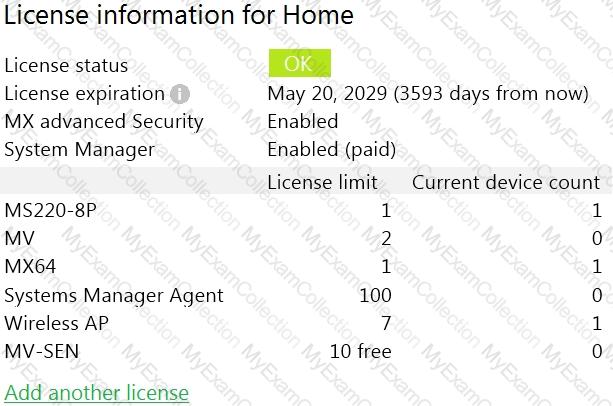For which two reasons can an organization become “Out of License� (Choose two.)
A new application needs to be pushed to all iOS devices. Some devices report “NotNow†in the event log and do not install the application.
What does the “NotNow†event indicate?
What are two ways peers interact with ports that Auto VPN uses? (Choose two.)
Which enrollment method must be used when containerization is required on BYOD Android devices managed by Systems Manager?
When wireless SSIDs are configured in Dashboard, which setting on the Access Control page affects the ability of a 2.4 GHz only client device from associating to the WLAN for the first time?
Refer to the exhibit.

This Dashboard organization uses Co-Termination licensing model.
What happens when an additional seven APs are claimed on this network without adding licenses?
Which three verbs of request are available in the Cisco Meraki API? (Choose three.)
Company iPads are enrolled in Systems Manager without supervision, and profiles are pushed through Systems Manager.
Which outcome occurs when a user attempts to remove the “Meraki Management†profile on an iPad?
When an SSID is configured with Sign-On Splash page enabled, which two settings must be configured for unauthenticated clients to have full network access and not be allow listed? (Choose two.)
What is out of scope when considering the Best practices for high-density wireless designs?
Which type of authentication protocol is used when using OSPF on an MX appliance?
Which configuration step is necessary when automatic updating is required of iOS apps provisioned through Systems Manager that are found in the App Store?
A Cisco Meraki MV camera is monitoring an office and its field of vision currently captures work desks and employee computer screens. However, recording employee computer screens is prohibited by local regulation.
Which feature in Dashboard can be used to preserve the current position of the camera while also meeting regulation requirements?
There will be 100 concurrent users streaming video to their laptops. A 30/70 split between 2.4 Ghz and 5 Ghz will be used. Roughly how many APs (rounded to the nearest whole number) are needed based on client count?

